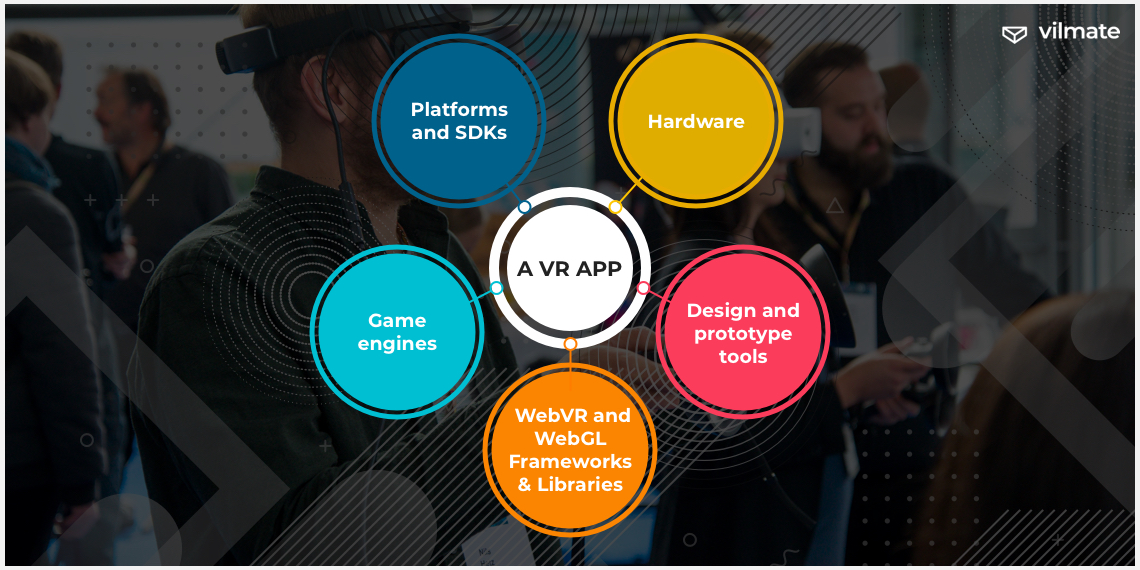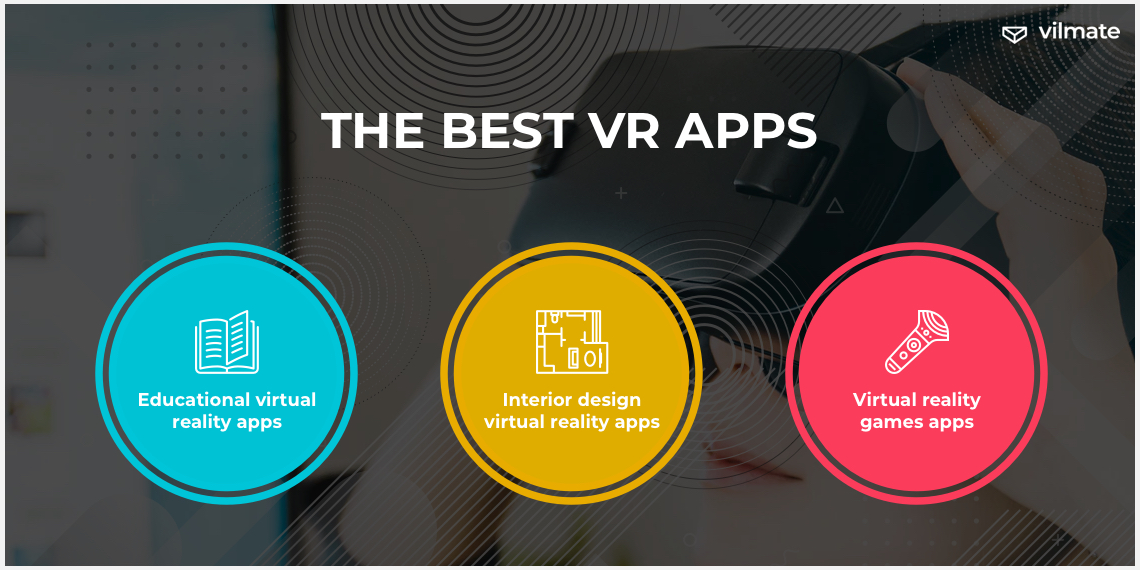The virtual reality market is generating a lot of money annually and 2019 was no exception. It was claimed in the eMarketer’s report that 42.9 million people in the US solely were predicted to use VR at least once per month. The numbers cannot but inspire business owners and all sorts of visionaries across the industries to channel into a virtual reality world. The steady growth left many of them wondering how to create VR apps and develop VR content for these apps so that to attract potential customers and generate some profit.
What is the VR app?
Virtual reality is the computer technology that creates artificial environments in the form of realistic stereoscopic 3D virtual interactive physical environments.
Computer applications, such as video games or apps for watching movies, allow us to be immersed in a fully virtual environment. On the desktop, we create our own immersive worlds. With the smartphone, it becomes available to us anywhere and everywhere we go.
So how is VR so immersive?
First, the images created in the computer are used to simulate the environment you are actually in. Second, the three-dimensional models of these environments are projected onto a screen, allowing the viewer to rotate and move around the images, so they appear as if they are floating on the wall. Third, the viewer's vision is distorted by a headset, allowing the images to appear to be floating through space and around you. The combination of these two elements creates a clear feeling of being inside a virtual world, even when the images are not actually there.
That's VR in a nutshell.
Suffice it to say, in 2020, the VR app can be compatible both with a smartphone and a desktop computer.
Virtual reality for smartphones
VR applications for iPhone and Android devices marked the leap to a consumer headset nurturing the next wave of VR products, even as mobile VR for PC tablets and smartphones pushed the edges of the market. Smartphone VR has the potential that many companies are still trying to live up to. Virtual reality on mobile phones has the competitive advantage of giving the freedom of creating immersive experiences on the go.
However, some virtual reality platforms like Google Daydream require launching into a separate app ecosystem, which most users find inconvenient. For example, Apple's removing the headset cord and blocking your phone from the screen, which actually enables iPhone VR applications. Besides, phone-based VR still has a number of other flaws to be corrected before it can deliver equally intense physical experiences as desktop-based VR.
Virtual reality for PCs
Most VR compatible apps are now designed for Windows, macOS, and Linux. Oculus Rift, HTC Vive, and PlayStation VR are some of the most popular devices available today to give you a cinematic experience, immersive gaming experience, and making virtual reality explorations possible. The immersive gaming experience will also be used for educational reasons, such as virtual reality education classes.
As VR becomes more popular, developers are thinking about how to adapt their designs to reach more people. While building VR games may still require particular skills, the developers are now learning the exact design constraints that must be met for different gaming experiences. This will allow them to design their titles to adapt to various PC and mobile devices while keeping users able to fully enjoy their games.
How to use VR in apps?
VR combines computer graphics and real-time simulations to create fully immersive three-dimensional experiences. There are many types of virtual reality headsets, and each type is targeted for different purposes. The most common form is called a head-mounted display (HMD), in which the user wears a head-mounted display that is attached to the user's head. Head-mounted displays are most often used in conjunction with a pair of devices called the HMD and the controllers, which help the user control the VR experience.
The second type of a virtual reality device is called a hand-held HMD, in which the user wears a hand-held VR device. The high-end HMD can be used to view images or videos or interact with real objects and places. The hand-held VR device can be used to more deeply experience VR using a more intuitive way of using the VR device.

Technical requirements for creating virtual reality
Virtual reality apps development is a complex process that requires strong expertise in a variety of tools and techniques to reach the quality levels necessary for commercial success. Thus, a key development principle in VR apps is to develop them with a high-performance, low-power architecture, with the complete application code in a container for efficient re-use. This includes software/hardware design that involves the use of prototyping tools, development environments, libraries and frameworks that have proven to be very beneficial for VR app development.
1. Platforms and SDKs. The best VR apps begin with choosing a proper platform and SDK. Software platforms like SteamVR, Oculus Home and XboxVR are supported out of the box. This means no extra software to install to get the experience, and users can be certain of consistent performance. The downside is that developers will need to build games specifically for these platforms, but this isn't something a user could worry about. So, you should start with the chosen brand’s specific SDK to develop your VR experiences.
2. Game engines. Game and VR engines are responsible for storing the data that the user’s eye sees. They render images and provide the input methods for the user’s brain. Examples include Nvidia's Havok, Unity's Game Studio, Unreal Engine, Gear VR's Unity3D, and their many proprietary counterparts. Virtual reality game engines are nowadays mostly free. They are easily integrated with platform-specific SDKs and can be easily customized with different APIs.
3. WebVR and WebGL frameworks & libraries. WebVR is a small piece of JavaScript that runs in the browser on the web and provides an API for use in virtual reality (VR) applications. Basically, WebVR makes it possible to experience VR in most of today’s browsers. WebGL, in turn, allows your application to present graphics on the browser. WebGL objects (including graphics libraries) are dynamic — they change with time and/or event handling, depending on the hardware you use and your web pages. That means that you'll need to create and destroy WebGL objects frequently.
In short, WebVR and WebGL libraries offer a real-time communication channel between the application code and hardware that is created by the application to render graphics.
4. Design and prototype tools. What makes a VR application really good is, to a great extent, its design. To develop a virtual reality application and to do it well, the development team has to consider prototyping VR experience for testing and validation purposes. Through prototyping, you can test a 360-degree view, a sense of scale and depth, the use of available sensors, the viewing position of the viewer and many more attributes. VR application software developers should be familiar with the creation of prototypes using Google Blocks, Cinema 4D, Photoshop, Sketch, Framer, and A-Frame. In the course of prototyping, it will get clear how to make VR animation and thus lay the ground for the success of your future VR app.
5. Hardware. If you're thinking of developing a VR app, you should also consider what kind of hardware you'll need to run it. There are several great choices, including two versions of the HTC Vive and Oculus Rift VR headsets that also come with sensor units. It's always a tradeoff to choose between less power and a more comfortable range of motion, but it's a necessary choice. One way or the other, both the Rift and Vive's sensor systems have minimum hardware requirements. Besides, there are a number of VR hardware types, including the following:
- Console
- Light mobile VR headsets
- Premium mobile VR headsets
- VR headsets connecting to external PCs
- Standalone headsets
- VR haptic feedback suits
Benefits of VR apps for businesses
When VR was just invented, in the 1960s, it only vaguely resembled modern virtual reality experiences we’re used to. Then, it was a dream that someday, businesses will be able to use it freely to their advantage. So, before setting out to create VR content for Google Cardboard, Samsung Gear VR, HTC Vive, Oculus Rift, Google Daydream or any other VR platform, it’s a good idea to make it clear, what benefits you’re pursuing by creating content for VR.
1. New experiences for attracting customers and nurturing their loyalty. VR technology provides businesses with a chance to fully connect with customers, even before they want to spend their money with them. Virtual reality offers enterprises the opportunity to create a new sense of engagement and authenticity between the companies, their brand, and their customers.
2. Effective VR-powered product development. Businesses that focus on creating real-life products must take advantage of so-called virtual rooms. These rooms can be used to maximize the teams’ effectiveness. VR-powered prototypes allow interacting virtually with a product and assessing it before you can actually touch and feel it. Developers, engineers, and designers become more productive and collaborative armed with VR. Accordingly, using VR demos at meetings is a great way to demonstrate the expected results to the stakeholders.
3. Immersive marketing. Virtual reality technologies are also an effective means of immersing customers in digital experiences, which in turn enables users to interact with brands and business brands in more meaningful ways. VR transfers marketing from telling stories to showing digital experiences and letting customers interact with a brand and its products. VR applications allow businesses to engage their customers in ways they may not have considered before.
The best VR apps
All in all, the best virtual reality apps have a huge impact on customers and the decisions they make. A quality virtual travel app will give users some wonderful world experiences. There's more to VR than simply "VR games." Virtual reality allows creating unique advertisement and entertainment experiences in such verticals as education, interior design, and games.

Educational virtual reality apps
There is definitely something amazing about being immersed in a 3D virtual reality world while getting educational experiences and learning something new. For instance, Oculus Go educational apps are one of the most popular categories in their library. There are numerous educational videos, presentations, and games made specifically to be streamed in 360 degrees. The Educational VR Industry has turned heads over the past two years with all the announcements and media covering this space. VR is poised to bring new life to education and help to enrich the overall experience for learners.
Interior design virtual reality app
Design VR apps are all about 3D, meaning 3D models that you can step around and experience in virtual reality, but it's not only the sense of presence that makes these apps so good. The control and feel of each experience is also something that a 3D model must achieve, making for a very pleasurable experience. Although VR within interior design and architecture landscape is still quite virtual, the technology is getting friendlier to users at a high pace, and therefore there are some very enjoyable VR experiences being created already, but they are usually only a quick taste of what you can have in the future.
Virtual reality games apps
Virtual reality is now mainstream chiefly due to the contribution of the videogames industry. Because video games use complex physics, and because visual displays are a key means of interaction, their interaction can never be the same as it is in conventional games. That’s why many game companies wonder how to make a VR game. Content for virtual reality games is growing exponentially. According to the 2019 Augmented and Virtual Reality Survey Report, the gaming sector (54%) is expected to be directed the most investment in 2020. It’s no surprise that gaming is the most promising area of development. Publishers are taking good note of it and are searching for new ways to improve user experience.
How much does it cost to create a VR app?
Not only how to create virtual reality content is the question. It is also important to know how much it may cost to develop a VR app. So, to estimate the project, companies developing VR should consider expense lines like:
- the manpower cost
- the development tools cost
- the IT infrastructure cost
- other operating expenses
If you are a company thinking to develop VR content, it is also important to consider the work speed of your team in order to get a realistic development time. Next, that company needs to consider the global market demand for the VR content. Also, the business will need to find the right vendor for their project. Vilmate is thus and so a software development company that delivers app development services to businesses in a variety of verticals. Building a virtual world and interactive virtual reality environments can, in turn, refer to nearly all the industries, too.
Let’s now get straight to the point. The process of virtual reality applications development will involve the following stages:
- Requirement Gathering & Analysis Phase
- UX/UI Design Development
- Software Development
- Software Testing
- Deployment
- Maintenance
At each stage, there will be a number of tech professionals involved. These include software engineers, UX/UI designers, web developers, Android and iOS developers, VR developers, QA engineers, DevOps engineers, a project manager, and a business analyst. The cost of manpower will always be very much dependent not only on the level of skill and respectively the complexity of the project but also on the geography. For instance, hiring developers from Eastern Europe will cost an average of $40 per hour. As a result, the cost of VR app development with the Eastern European team like Vilmate will range from $15,000 to as high as $100,000.
Conclusion
The world of VR is a promising field of investment for businesses. In this article, we’ve touched on the subject of how to make a VR app and how much it may cost. With all said, we insist that virtual reality is and will remain a popular topic for startups.
Of course, 3D VR video and animation is what makes VR applications different from regular apps we are used to. It is the factor that may cause a boost in app development cost, as well as the rapid popularity growth. Though it will not be an easy endeavor, you should take the risk. Explore the market for your business idea, make an effort, and get started with VR to engage your audience.

© 2020, Vilmate LLC




